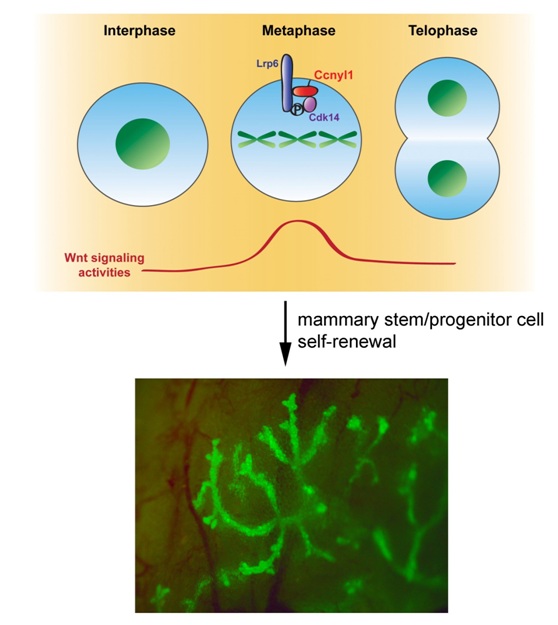Recently, Dr. ZENG Liyong, Dr. CAI Cheguo and their colleagues from Prof. ZENG Yi Arial’s group and Prof. ZHU Xueliang’s group at Institute of Biochemistry and Cell Biology (SIBCB), Shanghai Institutes for Biological Sciences (SIBS) of Chinese Academy of Sciences (CAS), have unraveled roles of the cyclins in mouse embryonic development and mammary stem/progenitor cell functions through joint effects. This work was published in PLoS Genetics.
The self-renewal of stem cells requires both cell division and at least one of the daughter cells retaining the stem cell properties. The Wnt signaling is essential for the self-renewal of, for instance, mammary stem cells. Cyclin Y (Ccny) and cyclin Y-Like 1 (Ccnyl1) are membrane-tethered cyclins, which were collectively named by Ccnys. Their activation of the cyclin-dependent kinase Cdk14 can lead to Lrp6 (Wnt co-receptor) phosphorylation, thus an enhanced Wnt signaling specifically in mitosis. Whether this regulatory cascade has physiological roles in stem cell self-renewal, however, is not known.
The researchers used mouse knockout models to explore physiological roles of the mitotic Wnt signaling. They found that, whereas the knockout of either Ccnyl1 or Ccny does not affect mouse embryonic development and maturation, the double knockout of both results in embryonic lethality at embryonic day 16.5. Ccnyl1 is highly expressed in mammary terminal end buds in the puberty stage, where dividing mammary stem/precursor cells are abundant.
Depletion of Ccnys abolished mammary stem/progenitor cell functions as shown by in vitro clonal expansion and transplantation experiments. Lineage tracing experiments revealed that Ccnys-deficient mammary stem/precursor cells lose their competitiveness and cease to contribute to mammary development in vivo.
Therefore, the boost of mitotic Wnt signaling by Ccnys is critical for mammary stem/precursor cells to maintain their stemness upon division.
The study was supported by grants from the Ministry of Science and Technology of China and National Natural Science Foundation of China.

Figure: During the mitosis of mammary stem/progenitor cells, Ccny and Ccnyl1 activate Cdk14 to phosphorylate Lrp6 Ser1490 site. This enhances the mitotic Wnt signaling and helps dividing mammary stem/progenitor cells to maintain their stem cell properties. (Image by Prof. ZENG Yi Arial 's lab)

